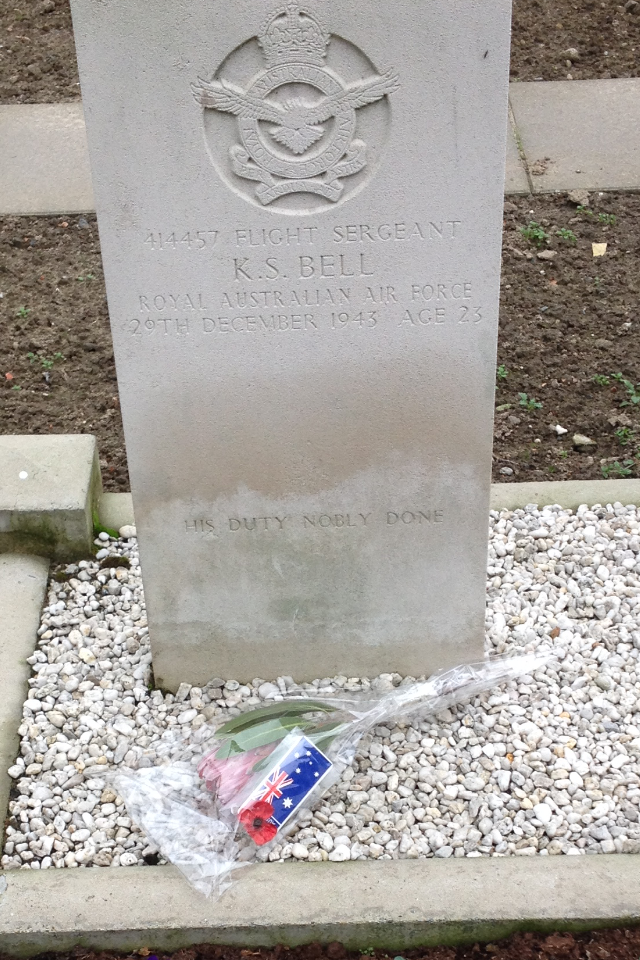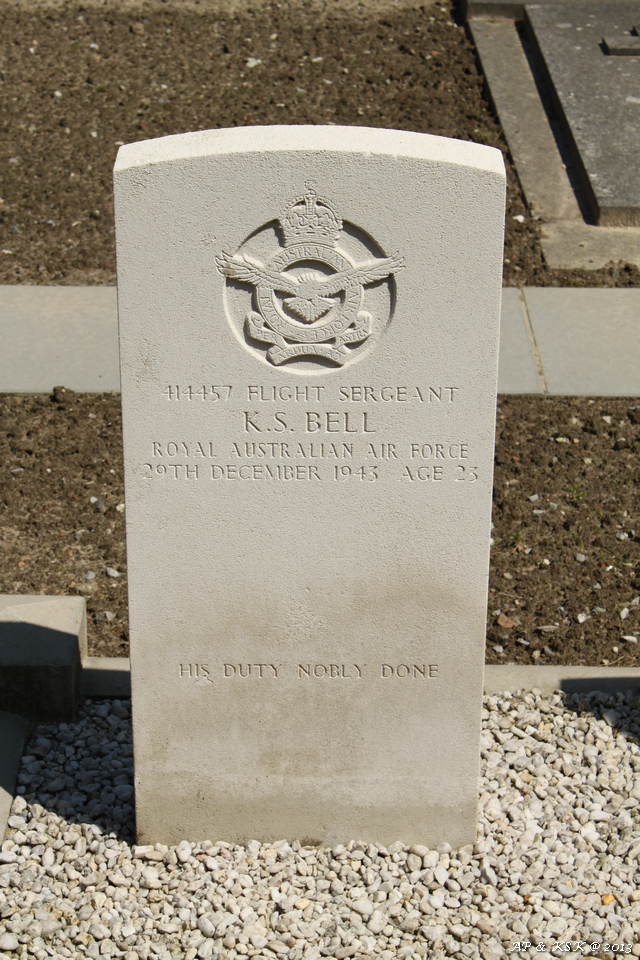Keith Selwyn Bell was born on 3rd May 1920, son of Gordon Percy and Minnie Bell of Cunnamulla, Queensland, Australia. He served as a Lieutenant in the Australian Militia Force and joined the Royal Australian Air Force in Brisbane on 11th October 1941, training as a bomb aimer. He eventually went on to serve with No.115 Squadron, Royal Air Force, which was operating Lancaster bombers out of Witchford, Cambridgeshire. On 29th December 1943, F/Sgt Bell and his crew were part of an operation to Berlin. 712 bombers were tasked with attacking the German capital on this night and Lancaster II DS834 KO-F, with F/Sgt Bell aboard, took off from its base at 17.28. The weather was dismal, hindering the bombers but also keeping the Luftwaffe at their bases for a long time. From 17.00hrs the Germans reported the Bombers coming in, quickly discovering that Berlin would be the target that night. The Pilot, F/Sgt Lee reached the German capital and, once they had dropped their bombs, turned the mighty bomber to fly back home. All seemed well until, at the Dutch/German border, contact was made with a Messerschmit Bf-110 flown by Leutnant Otto Fries of 5./NJG1, stationed at St. Trond in Belgium. Lt. Fries had been patrolling his 'box' when the ground controller vectored him to the Lancaster of F/Sgt Lee and a fierce fight would soon ensue. At exactly 22.00 Lt. Fries started his attack. Slowly he manoeuvred his night fighter underneath the Lancaster. Just at the moment he fired his guns, he was made out by the tail gunner of the Lancaster, Sgt Johnson, who fired at the German plane. Both seemed to miss. F/Sgt Lee took extreme evasive action to try and shake off the German and both the bomber and night fighter found themselves in a 'corkscrew'. For more than ten minutes the two planes were engaged in a deadly fight which looked more like a dog fight between two fighter planes. The Germans later reported that the Lancaster pilot took evasive action which seemed incomprehensible for a heavy bomber like the Lancaster. It was desperately trying to reach the safety of a layer of clouds. The planes were manoeuvring, hardly able to take aim at each other. By now F/Sgt Lee was demanding so much from his plane and pushing the Lancaster to it limits, that Lt. Fries saw the wings vibrate under the stress. Lt. Fries then fired a salvo into the right inner engine, which began to trail smoke. Then he hit the left wing, which exploded. Apparently he had hit the fuel tank. The Lancaster slid over to its left side and went down. It disappeared in a layer of cloud and not long after the German crew saw an orange glow coming from the ground. Three of the Lancasters crew, F/Sgt Lee, Sgt A F Gunnell, and Sgt H L Pike managed to bale out from the plane. The others went down with it and died when it crashed near the Dutch town of Tungelroij, near Weert. Sgt Gunnell managed to evade capture and eventually made his way back to the UK. The other two were captured not long after they landed by parachute. All four crewman who perished are buried at the Weert (Tungelroij) Roman Catholic Cemetery. F/Sgt Bell's older brother, Melvyn, also joined the R.A.A.F. and won the American Silver Star while he was stationed with an American Bomber Squadron in the Pacific theatre...
Info: Brett Munro
Keith Selwyn Bell was born on 3rd May 1920, son of Gordon Percy and Minnie Bell of Cunnamulla, Queensland, Australia. He served as a Lieutenant in the Australian Militia Force and joined the Royal Australian Air Force in Brisbane on 11th October 1941, training as a bomb aimer. He eventually went on to serve with No.115 Squadron, Royal Air Force, which was operating Lancaster bombers out of Witchford, Cambridgeshire. On 29th December 1943, F/Sgt Bell and his crew were part of an operation to Berlin. 712 bombers were tasked with attacking the German capital on this night and Lancaster II DS834 KO-F, with F/Sgt Bell aboard, took off from its base at 17.28. The weather was dismal, hindering the bombers but also keeping the Luftwaffe at their bases for a long time. From 17.00hrs the Germans reported the Bombers coming in, quickly discovering that Berlin would be the target that night. The Pilot, F/Sgt Lee reached the German capital and, once they had dropped their bombs, turned the mighty bomber to fly back home. All seemed well until, at the Dutch/German border, contact was made with a Messerschmit Bf-110 flown by Leutnant Otto Fries of 5./NJG1, stationed at St. Trond in Belgium. Lt. Fries had been patrolling his 'box' when the ground controller vectored him to the Lancaster of F/Sgt Lee and a fierce fight would soon ensue. At exactly 22.00 Lt. Fries started his attack. Slowly he manoeuvred his night fighter underneath the Lancaster. Just at the moment he fired his guns, he was made out by the tail gunner of the Lancaster, Sgt Johnson, who fired at the German plane. Both seemed to miss. F/Sgt Lee took extreme evasive action to try and shake off the German and both the bomber and night fighter found themselves in a 'corkscrew'. For more than ten minutes the two planes were engaged in a deadly fight which looked more like a dog fight between two fighter planes. The Germans later reported that the Lancaster pilot took evasive action which seemed incomprehensible for a heavy bomber like the Lancaster. It was desperately trying to reach the safety of a layer of clouds. The planes were manoeuvring, hardly able to take aim at each other. By now F/Sgt Lee was demanding so much from his plane and pushing the Lancaster to it limits, that Lt. Fries saw the wings vibrate under the stress. Lt. Fries then fired a salvo into the right inner engine, which began to trail smoke. Then he hit the left wing, which exploded. Apparently he had hit the fuel tank. The Lancaster slid over to its left side and went down. It disappeared in a layer of cloud and not long after the German crew saw an orange glow coming from the ground. Three of the Lancasters crew, F/Sgt Lee, Sgt A F Gunnell, and Sgt H L Pike managed to bale out from the plane. The others went down with it and died when it crashed near the Dutch town of Tungelroij, near Weert. Sgt Gunnell managed to evade capture and eventually made his way back to the UK. The other two were captured not long after they landed by parachute. All four crewman who perished are buried at the Weert (Tungelroij) Roman Catholic Cemetery. F/Sgt Bell's older brother, Melvyn, also joined the R.A.A.F. and won the American Silver Star while he was stationed with an American Bomber Squadron in the Pacific theatre...
Info: Brett Munro
Sponsored by Ancestry
Advertisement
Explore more
Sponsored by Ancestry
Advertisement



